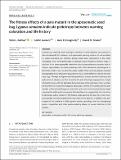Files in this item
The fitness effects of a pale mutant in the aposematic seed bug Lygaeus simulans indicate pleiotropy between warning coloration and life history
Item metadata
| dc.contributor.author | Balfour, Vicki L. | |
| dc.contributor.author | Aumont, Cédric | |
| dc.contributor.author | Dougherty, Liam R. | |
| dc.contributor.author | Shuker, David M. | |
| dc.date.accessioned | 2018-12-11T13:35:16Z | |
| dc.date.available | 2018-12-11T13:35:16Z | |
| dc.date.issued | 2018-12 | |
| dc.identifier | 256498783 | |
| dc.identifier | b3fe8efe-97ad-4737-9e55-c3ffc2b41f8e | |
| dc.identifier | 85057767127 | |
| dc.identifier | 000454523500044 | |
| dc.identifier.citation | Balfour , V L , Aumont , C , Dougherty , L R & Shuker , D M 2018 , ' The fitness effects of a pale mutant in the aposematic seed bug Lygaeus simulans indicate pleiotropy between warning coloration and life history ' , Ecology and Evolution , vol. 8 , no. 24 , pp. 12855-12866 . https://doi.org/10.1002/ece3.4723 | en |
| dc.identifier.issn | 2045-7758 | |
| dc.identifier.other | RIS: urn:3D0771CCFA0A697CFBB0DCC6FD1DEE4E | |
| dc.identifier.other | RIS: urn:3D0771CCFA0A697CFBB0DCC6FD1DEE4E | |
| dc.identifier.other | ORCID: /0000-0003-4203-3057/work/140362638 | |
| dc.identifier.uri | https://hdl.handle.net/10023/16662 | |
| dc.description | VLB is funded by a University of St Andrews PhD Apprenticeship. In addition, the authors would like to thank the University of St Andrews for funding open-access for this paper. | en |
| dc.description.abstract | Conspicuous warning colors that signal chemical or other defenses are common in the natural world. For instance, such aposematic warning patterns of red-and-black or yellow-and-black are common among insect taxa, particularly in the order Hemiptera, often forming the basis of Batesian and/or Müllerian mimicry rings. In addition, it has been repeatedly noted that color polymorphisms or mutants that influence pigmentation can show pleiotropy with other behavioral, physiological, or life-history traits. Here, we describe a pale mutant of the seed bug Lygaeus simulans that appeared in our laboratory population in 2012, which differs in color to the wild-type bugs. Through multigenerational experimental crosses between wild-type and pale mutant L. simulans, we first show that the pale phenotype segregates as a single Mendelian locus, with the pale allele being recessive to the wild type. Next, we show (a) that there is a large heterozygous advantage in terms of fecundity, (b) that pale females suffer reduced longevity, and (c) that pale males have increased body length compared to wild-type homozygotes. Our data therefore suggest that the color locus is pleiotropic with a number of life-history traits, opening the door for a more complete genetic analysis of aposematic coloration in this species. In addition, this phenotype will be useful as a visible genetic marker, providing a tool for investigating sperm competition and other post-copulatory drivers of sexual selection in this species. | |
| dc.format.extent | 12 | |
| dc.format.extent | 1197180 | |
| dc.language.iso | eng | |
| dc.relation.ispartof | Ecology and Evolution | en |
| dc.subject | Aposematism | en |
| dc.subject | Color polymorphism | en |
| dc.subject | Life-history | en |
| dc.subject | Pleiotropy | en |
| dc.subject | Supergene | en |
| dc.subject | QH301 Biology | en |
| dc.subject | DAS | en |
| dc.subject.lcc | QH301 | en |
| dc.title | The fitness effects of a pale mutant in the aposematic seed bug Lygaeus simulans indicate pleiotropy between warning coloration and life history | en |
| dc.type | Journal article | en |
| dc.contributor.institution | University of St Andrews. School of Biology | en |
| dc.contributor.institution | University of St Andrews. Centre for Biological Diversity | en |
| dc.contributor.institution | University of St Andrews. Scottish Oceans Institute | en |
| dc.contributor.institution | University of St Andrews. Institute of Behavioural and Neural Sciences | en |
| dc.identifier.doi | 10.1002/ece3.4723 | |
| dc.description.status | Peer reviewed | en |
This item appears in the following Collection(s)
Items in the St Andrews Research Repository are protected by copyright, with all rights reserved, unless otherwise indicated.

